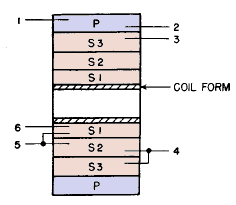| Electronic Transformers and Circuits is a free introductory textbook on transformers and related circuits. See the editorial for more information.... |

|

Home  Rectifier Transformers and Reactors Rectifier Transformers and Reactors  Combined Anode and Filament Transformers Combined Anode and Filament Transformers |
||||||
| See also: Anode Transformers, Anode Transformer Design, Filament Transformers | ||||||






|
||||||
Combined Anode and Filament Transformers
Anode and filament windings are combined into a single transformer mainly in low-power ratings such as those in receivers and grid bias power supplies.
One widely used combination includes the anode and filament windings for a rectifier and a filament winding for the amplifier tubes.
Combined anode and filament transformers are difficult to test for regulation or output voltage aside from operation in the rectifier circuit itself, because a-c loads do not duplicate rectifier action. Most transformers of this kind are used in rectifiers with capacitor-input filters or with fixed loads in which regulation is not important. Ratings are easier to predict. Anode secondary v-a rating is the product of rms voltage and current, but the corresponding portion of primary v-a rating depends on the rectifier and is found as mentioned in Rectifiers with Reactor-Input Filters and Rectifiers with Capacitor-Input Filters. To this is added the sum of filament winding v-a ratings, and the primary current can then be calculated from the total volt-amperes.
|
||||||
Home  Rectifier Transformers and Reactors Rectifier Transformers and Reactors  Combined Anode and Filament Transformers Combined Anode and Filament Transformers |
||||||
Last Update: 2011-01-05



